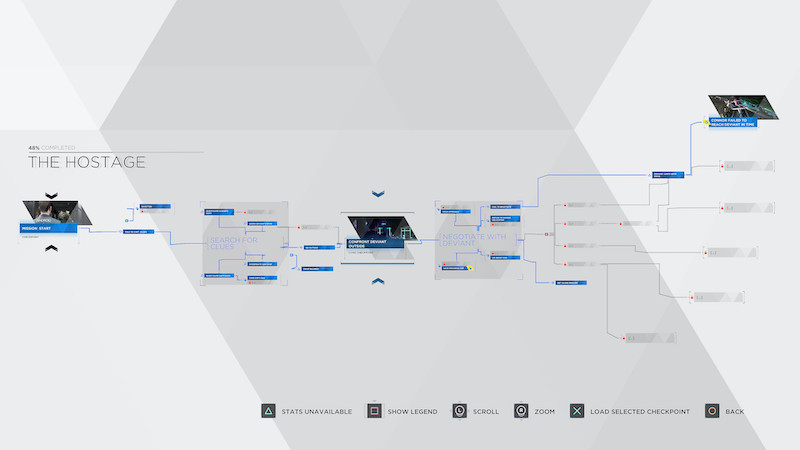Star Wars Oil Paintings

I’ll always have a soft spot for Star Wars things, but these paintings by Naci Caba are wonderful. The colors add a great bit of flavor especially to scenes in space that would otherwise be predominantly black and grey.
Detroit: Become Human

Detroit: Become Human is a story-heavy adventure game developed by Quantic Dream, the studio I knew best as the creators of Heavy Rain.
The story takes place in a future where androids are commonplace and indistinguishable from humans aside from a computer chip placed on their temple. Predictably, the androids are mistreated and repressed by humans, and you eventually find yourself in the middle of a robot uprising.
You assume the role of three different characters with interweaving narratives, and the actions you take as each character determine the course of the story. The result is a giant web of branching storylines with many different possible outcomes.
Roleplay
The key to making this type of game engaging is how well you can sympathize with and roleplay as the protagonists. If you understand the characters and their motivations – and can see the world through their eyes – each of the actions you take over the course of the story becomes more meaningful.
Robots do as they are told
In one early scene, you play as an android who is newly hired as a maid. You are set to performing menial tasks around the house, like picking up trash and washing dishes. Working through these tasks establishes your role as someone who does what they are told (It was even a little unnerving how eagerly I worked on these missions, happy to keep checking off finished work in the mission list). Because of this initial set-up, taking an action that goes against your owner’s orders becomes a much more meaningful scene.
What should I want to do?
While playing as another of the three main characters, an early scene presented what I thought would be a difficult, morally ambiguous decision to make. But as I was considering what the best action might be, the cutscene continued and the character made his own decision without any input from me. I was relieved that the difficult choice wasn’t my responsibility, and this scene was very important in establishing who this character is and how he behaves in certain situations.
But it was this character that I had the most difficulty playing as the story progressed. I was never sure if I should make decisions based on “What I want to do” or “What I think he would do” or “What I think he should do”. Do I follow my understanding of this person’s personality and values, or do I push him to change and break out of his mold? Probably because of my indecision, I ended up not being able to do a good job of either. Seeing the conclusion of the story showed me which decision would have led to a more positive ending, but the right path wasn’t clear to me on my first playthrough.
Exploring the Story
Detroit: Become Human shows you how your decisions affect the story in the form of a map with branches leading to different outcomes.

I’m not sure if this is a feature common to adventure games (I hadn’t seen it before), but this was a godsend when making multiple playthroughs. You can even jump to a point in the story that you had already seen and start playing again from that point, free to make different decisions to unlock new parts of the story. You can’t help but wonder what would have changed if you acted a different way, and this lets you see without having to start the game from the beginning and skip through 80% identical cutscenes. It was because of this freedom and ease of access that Detroit: Become Human became the first game in recent memory in which I unlocked 100% of achievements.
Purists might say that this ability to jump around the story detracts from the experience, but I honestly think I wouldn’t have played the game a second time without it. As a result, this feature is what allowed me to experience the amazing story in its entirety.
If the developers had chosen to design a game that presents the story from start to finish in the best way possible, they might not have included this map. I think that many existing adventure games had this approach. But instead, I think this game chose to present the story including all of the branching outcomes in the best way possible. None of the paths is the one correct path. They all tell parts of the same story, and I was very glad to have had the complete experience.
Box Line Text: A minimal whiteboard app
This is a great implementation of an extremely minimal whiteboard app. There is no UI, and you can click to add text or click+drag to add boxes and lines. Zoom options in your browser will change the size, and you can save the HTML if you want to keep a copy.
It’s probably not enough for work meetings, but I thought it was a great, fun product.
What staying home has been like for me so far
Things that changed
- I have more time in the morning to do things around the house instead of commuting
- Remote meetings are a little harder than in-person meetings
- I write daily reports about my work progress, equally to show my teammates that I’m staying on track, and to keep myself on track
- We watch the news a lot more
- I don’t wear socks
- Pushing my social life online has lead to me talking to friends more than before
Things that didn’t change
- Waking up in the morning is hard
- Work hours are mostly the same, or a little longer from the lack of a commute
- There is still a lot of work to do and I am busy
- I still shave and brush my teeth and shower
- I get dressed in the morning
- We get groceries delivered once a week
- The world is stressful, but being able to stay at home is a blessing so total stress balances out
- The dog doesn’t seem to care that I’m around
Wag Buys Shares Back from SoftBank
Wag was looking to raise $75 million. It went to SoftBank and was like “will you give us $75 million?” SoftBank was like “no haha we’ll give you $300 million,” because that is SoftBank’s whole thing, it loves to give startups vastly more money than they want or need. And so Wag took the money. And then like a year and a half later Wag will get rid of SoftBank by giving back, I don’t know, but I am going to say some number less than $225 million (“well below” the valuation at which it invested). Wag got the $75 million it needed for free.
So under the right circumstances, you can make more money with a flop than you can with a hit!
Wag wasn’t exactly a flop, but SoftBank’s aggressive investment strategy does result in some pretty unusual situations.
Leather Sneakers by Spingle

Spingle is a company based in Hiroshima, Japan that makes hand-crafted leather shoes, and they also have an excellent sneaker lineup. Because the leather molds to your feet over time, the shoes become more comfortable the more you wear them.
They are a little pricey, but they should last a long time and the cost is completely reasonable considering the work that goes into them. And there are plenty of sneakers that cost even more.
An AI That Begins Novels
This neural network was trained to output unique opening lines to novels. Some of the results are surprisingly great:
I have just been informed, that the debate over the question ‘is it right or wrong to have immortal souls’ has been finally brought to a conclusion.
When I was a boy, I was fond of the story of the pirate god.
He had a strange name, and he was a very big boy indeed.
The village of Pembrokeshire, in the county of Mersey, lies on a wide, happy plain, which, in a few years, was to become known as the “Land of the Endless Mountains.”
I was playing with my dog, Mark the brown Labrador, and I had forgotten that I was also playing with a dead man.
How many times have I had the misfortune to die?
The first day I met my future self, I was aboard the old dirigible that lay in wait for me on the far side of the moon.
It’s hard to call these creative since the AI probably has no concept of what these words actually mean, but there are some really compelling ideas in here.
The last sentence in particular struck me as having so many interesting elements that could be explored more as the story progresses. At the very least, these serve as excellent starting places for ideas that a normal person wouldn’t have on their own.
Shape Up - How Basecamp does Product Development
Shape Up is an amazing new web-book by Basecamp that details the process they use to define, build, and ship their products. It has great insights, but I especially appreciated how many of the ideas presented just make a lot of sense. I often nodded along in agreement and recognized concepts that we share in our team. The framework is battle-tested and realistic, and there’s a good chance I’ll be able to integrate some new ideas into our existing workflow without having to reorganize how we think about everything to fit a new metaphor.
What I found the most impressive was how clearly they have defined the key ideas and concepts behind their process. Even if your team can find a groove and settle into a good way to work effectively, it takes a lot more effort to recognize why these things work and how they can be reproduced in different situations. Reading this document helped to solidify a lot of ideas I had encountered before but not fully appreciated.
The full document deserves a thorough read-through, but here is a summary of the main points for quick reference:
- Raw ideas are shaped into a concept pitch, with implementation details left open for the team to work out.
- Pitches are considered at a betting table and chosen for six-week work cycles.
- Small teams of developers and designers will be given a shaped concept and six uninterrupted weeks to finish.
- Work is broken up into scopes that incorporate front and back-end work. Scopes are finished roughly in sequence.
- The status of scopes is displayed as being uphill (still containing unknowns) or downhill (solved and being executed)
- The work must be shipped within the allotted time. Unfinished work won’t get an extension
- Meanwhile, new concepts are shaped in parallel. The next betting table is held during a two-week cooldown between cycles.
Ōkunoshima - The Island of Bunnies

Located east of Hiroshima in the Seto Inland Sea, Ōkunoshima (大久野島) is a small island home to over 700 rabbits. The rabbits are wild but friendly, and tourists arrive every day with bags full of food and treats. The island was relatively unknown in Japan until recently when its populality among foreign visitors brought it into the spotlight.
NAVA Ora Unica Wristwatch

I happened upon this watch in the mall over the weekend and loved how unconventional it is. The inner end of the loop acts as the hour hand, and the outer end is the minute hand. The in-between part seems to move freely, so you have a watch face that looks pretty different each time you look at it.
I’d probably need to pause for a few seconds to decipher the time so it’s not exactly practical, but it would be a good conversation starter for sure.